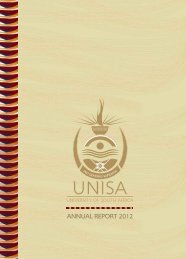Unisa 2008 Research Report - University of South Africa
Unisa 2008 Research Report - University of South Africa
Unisa 2008 Research Report - University of South Africa
You also want an ePaper? Increase the reach of your titles
YUMPU automatically turns print PDFs into web optimized ePapers that Google loves.
ACCORDInG TO ClIMATOlOGIST<br />
Pr<strong>of</strong>. Jana Olivier, associate pr<strong>of</strong>essor in the<br />
School <strong>of</strong> Environmental Sciences in <strong>Unisa</strong>’s<br />
College <strong>of</strong> Agriculture and Environmental<br />
Sciences, and project leader <strong>of</strong> the collaborative<br />
research project on fog harvesting, “Fog is an<br />
<strong>of</strong>ten underestimated source <strong>of</strong> water, even<br />
though it is the major source <strong>of</strong> water for many<br />
desert plants and animals, for example a beetle<br />
in the namib that collects fog on its hind legs<br />
by doing a ‘hand-stand’ to lift its hind legs into<br />
the air. The water droplets collected on the<br />
beetle’s legs and back then run downward to<br />
its mouth.” This description can be adequately<br />
used to describe the fog water collection<br />
system designed by the project team, consisting<br />
<strong>of</strong> Pr<strong>of</strong>. Olivier and Pr<strong>of</strong>. Johan van Heerden<br />
(emeritus pr<strong>of</strong>essor at the <strong>University</strong> <strong>of</strong><br />
Pretoria).<br />
fog wateR collection a<br />
natuRal pRocess<br />
Fog contributes significantly to the hydrological<br />
balance in forested areas by collecting on vegetation<br />
and dripping to the ground. By imitating<br />
this natural process, water can be collected for<br />
human applications, ranging from drinking<br />
water to the establishment <strong>of</strong> woodlots, vegetable<br />
gardens and livestock management.<br />
Fog and cloud are composed <strong>of</strong> minute<br />
droplets suspended in air. These droplets are<br />
initially very small ranging from a few microns<br />
to 100 microns in diameter depending upon<br />
the type <strong>of</strong> nuclei on which they are condensed.<br />
They are so small that they can easily<br />
be kept in suspension by air currents. However,<br />
when they collide with a solid surface, the<br />
droplets are deposited on the surface. As more<br />
and more accumulate, they grow until a larger<br />
drop is formed. Fog harvesting (or cloud water<br />
collection) is concerned with the collection <strong>of</strong><br />
these drops.<br />
The first significant experiment to collect drinking<br />
water from fog was conducted in 1995,<br />
when the Water <strong>Research</strong> Commission funded<br />
a project to determine the feasibility <strong>of</strong> using<br />
fog to supplement water sources in rural areas.<br />
Based on the results <strong>of</strong> this project, two projects<br />
were initiated to implement operational<br />
fog water systems in rural areas and to supply<br />
communities with water.<br />
eaRly expeRimental<br />
systems<br />
The first <strong>of</strong> these fog water collection systems<br />
was set up at the Tshanowa Junior Primary<br />
School in the Soutpansberg in Venda, and the<br />
second at a small mission village called lepelfontein<br />
on the West Coast. yields <strong>of</strong> around 5 l<br />
per m 2 per day were obtained at both these experimental<br />
sites, with maximum daily yields<br />
reaching 3 800 l per day at each.<br />
Additional systems were subsequently set up<br />
near Tshanowa, at lepelfontein, as well as in<br />
the Transkei and near langebaan in the Western<br />
Cape. The latest fog harvesting system was<br />
set up at Cabazana in the Eastern Cape in April<br />
<strong>2008</strong>.<br />
The cloud water collection systems have been<br />
designed to allow the small fog droplets to<br />
pass through a mesh. During this passage the<br />
flow is disturbed and a small percentage <strong>of</strong> the<br />
droplets collide with the mesh material and are<br />
collected. The water quality <strong>of</strong> fog is very high<br />
and conforms to World Health Organisation<br />
and <strong>South</strong> <strong>Africa</strong>n water quality standards for<br />
potable water.<br />
advantages <strong>of</strong> fog<br />
haRvesting<br />
Some <strong>of</strong> the advantages <strong>of</strong> fog harvesting are:<br />
• Both rainfall and fog droplets are collected,<br />
which makes it especially effective during a<br />
light drizzle.<br />
• Foggy conditions occur throughout the year<br />
and not only during the rainy season.<br />
• Fog is a sustainable source <strong>of</strong> water, even in<br />
times <strong>of</strong> drought.<br />
• Fog harvesting is ideal in mountainous areas<br />
where there are no other sources <strong>of</strong> water,<br />
where there are logistical difficulties, or<br />
where the costs are too high.<br />
• The system can be applied in sparsely<br />
populated areas.<br />
• Environmentally speaking, the impact <strong>of</strong> the<br />
systems is minimal during construction, the<br />
system does not influence the amount <strong>of</strong><br />
water available to the surrounding vegetation,<br />
and it does not require electricity.<br />
• Fog/mist is exceptionally clean and does not<br />
contain harmful micro-organisms.<br />
Fog water harvesting can thus be an important<br />
source <strong>of</strong> water in those areas where other,<br />
more conventional systems, cannot be used –<br />
specifically in the mountainous areas <strong>of</strong> the<br />
country. Ideally an integrated water management<br />
scheme should be implemented in these<br />
areas, using a combination <strong>of</strong> fog water collection<br />
as well as rainfall harvesting from ro<strong>of</strong>s<br />
and other structures.<br />
Pr<strong>of</strong>. Jana Olivier<br />
stRuctuRe <strong>of</strong> the fog<br />
haRvesting system<br />
The original systems comprised <strong>of</strong> a 70 m 2<br />
collecting surface consisting <strong>of</strong> a double layer <strong>of</strong><br />
30% shade cloth net. This was attached to<br />
wooden poles, anchored by means <strong>of</strong> steel<br />
cables with a gutter attached to the lower end<br />
<strong>of</strong> the net. Water droplets that collect on the<br />
screen run downwards and drip into the gutter<br />
from where they are channelled via pipes to<br />
storage tanks. The system was specially designed<br />
to be used in rural areas, to be as cost<br />
effective as possible, to use material that was<br />
readily available in the area, and to be suitable<br />
for use in areas with no electricity.<br />
Extensive damage was caused to the Transkei<br />
systems, primarily due to poor maintenance,<br />
vandalism and freak storms that ravaged the<br />
area during 2006 to 2007. It was also found<br />
that the shade cloth screens frayed and tore<br />
due to continuous rubbing against the steel<br />
cables during windy conditions. This necessitated<br />
the redesigning <strong>of</strong> the materials and<br />
structure. The following two modifications<br />
were therefore introduced:<br />
• Instead <strong>of</strong> a single flat collector, a system<br />
consisting <strong>of</strong> three 40 m 2 panels arranged<br />
in the shape <strong>of</strong> an equilateral triangle is now<br />
being used. A number <strong>of</strong> these systems can<br />
be linked together to expand the system to<br />
the required size. This design lends stability<br />
to the system so as to withstand the<br />
onslaught <strong>of</strong> gale-force winds.<br />
• The shade cloth has also been replaced with<br />
a stronger, stainless steel-based mesh.<br />
numerous experiments were conducted to<br />
compare the efficacy <strong>of</strong> the stainless steel<br />
mesh with that <strong>of</strong> shade cloth. It was found<br />
that the water collection efficacy <strong>of</strong> the steel<br />
mesh is satisfactory.<br />
31

















